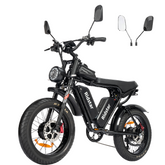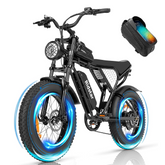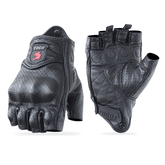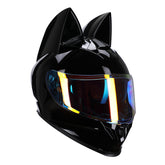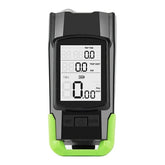Ridstar Q20 vs Q20 Pro: Which Fat Tire E-Bike Is Right for You in 2025?
Ridstar Q20 Battery Life: How Long Does It Last? Charging & Care Guide
Jan 9, 2025 · By Ridstar Blog Team
The battery is the heart of your e-bike. If you’re considering the Ridstar Q20 (1500W · 48V · 20Ah) —or you already own one—this guide explains real-world battery life, how to charge it the right way, and the habits that keep it healthy for years.
Quick Specs (Q20 Battery)
- Type: 48V 20Ah removable lithium-ion pack (buy the official Q20 battery)
- Typical Range: ~31–37 mi (50–60 km) throttle; up to ~56–62 mi (90–100 km) pedal assist
- Charge Time: ~6–7 hours with the original Ridstar charger
- Cycle Life: ~800 full cycles under proper care (often 3–5 years of regular use)
- Removable: Yes — charge on or off the bike; consider a spare pack & accessories
How Long Does the Q20 Battery Last Per Charge?
Real-world range depends on the ride, not just the spec sheet. Use this as a practical baseline:
| Scenario | Assist Level | Typical Range |
|---|---|---|
| Urban commute, mostly flat (rider ~75 kg) | PAS 2–3 | 45–60 mi (72–96 km) |
| Mixed terrain with hills | PAS 3–4 | 35–50 mi (56–80 km) |
| Full-throttle fun rides | Throttle only | 31–37 mi (50–60 km) |
| Cold weather (≤5 °C/41 °F) | Any | Expect ~15–30% less than usual |
Pro tip: If you’re commuting ~9–12 miles (15–20 km) daily, many riders charge every 2–3 days.
What Most Impacts Your Range?
- Assist Mode & Speed: Higher PAS or long full-throttle stretches consume more energy.
- Terrain & Starts: Hills, headwinds, frequent stop-and-go = higher draw.
- Load: Rider + cargo weight affects current draw during acceleration and climbs.
- Tire Pressure: Under-inflation increases rolling resistance (check weekly).
- Temperature: Lithium cells are less efficient in the cold—keep the pack warm before riding.
- Drive Train Health: A clean, lubricated chain reduces wasted watts; replace worn brake pads to avoid drag (brake pads, brake set).
Charging the Q20 the Right Way
The Q20’s battery includes a BMS (Battery Management System) that manages cut-off and protection. Still, habits matter for longevity.
Do
- Use the original Ridstar charger on a dry, ventilated surface.
- Charge between 20%–85% for everyday use; full charge before a big ride.
- Unplug within a few hours of reaching 100% (the BMS helps, but heat is the enemy).
- For long storage (≥2 weeks), leave it around 50%–70% and top up monthly.
Don’t
- Let the pack sit at 0%—deep discharge accelerates aging.
- Charge under a blanket, in direct sun, or near heat sources.
- Use third-party fast chargers—higher current = more heat and stress.
Need a spare or replacement? See the official Q20 48V 20Ah battery.
Battery Care & Everyday Habits
- Keep it clean & dry: Wipe contacts; avoid high-pressure washing around the battery bay.
- Store smart: Room temperature is ideal. Avoid extreme heat/cold when parked.
- Ride smooth: Gradual starts and moderate PAS go further than repeated sprints.
- Check hardware: Ensure the battery is firmly locked in the frame; consider a battery bracket for extra stability.
- Top up before you go: Keep a routine—reliability beats range anxiety.
Looking for add-ons that boost utility? Explore Ridstar accessories.
When Should I Replace the Battery?
Signs it’s time:
- Range has dropped ~30–40% versus new under similar conditions.
- Noticeable voltage sag (power dips) on moderate hills at mid-charge.
- The pack won’t balance to a full charge despite normal charging behavior.
Replacement is simple with the official Q20 battery. If you need help verifying fitment, contact us via Customer Support.
FAQs
1) Will overcharging damage the Q20 battery?
The BMS prevents overcharge by cutting off current at full. That said, keeping a pack at 100% for days can hasten aging. For daily use, charge to ~80–90% and top off before long rides.
2) How many years will the Q20 battery last?
With proper care, most riders see 3–5 years of useful life (~800 cycles). Your mileage varies by climate, load, and charging habits.
3) Can I fast-charge the Q20?
We recommend the standard Ridstar charger. Faster charging increases heat and cell stress—fine for emergencies, not ideal for longevity.
4) My winter range is lower—normal?
Yes. Cold reduces cell efficiency. Keep the pack warm indoors before riding and use lower PAS until it warms up in use.
5) What if I need to travel farther than one pack allows?
Carry a spare 48V 20Ah battery or plan a mid-ride charge stop with the compact Ridstar charger.
Ready to Ride Farther?
Explore the Ridstar Q20, grab an extra battery, and browse Q20 accessories for the perfect setup. Already ordered? Track it here: Order Tracking.
Questions about compatibility or care? Reach us anytime via Contact Us or see store policies: Shipping, Returns, Privacy, Terms.

